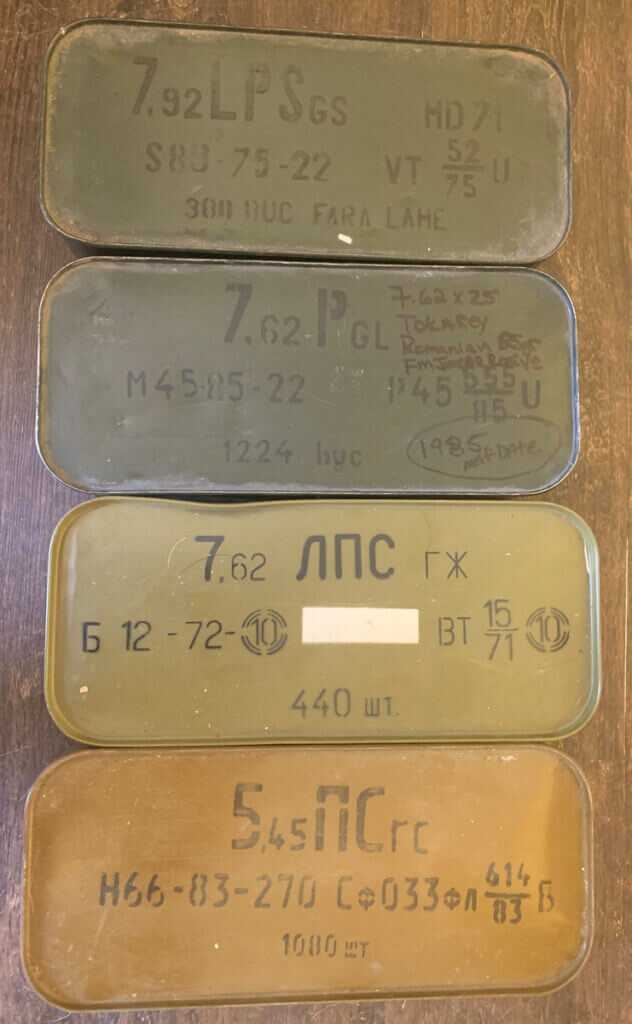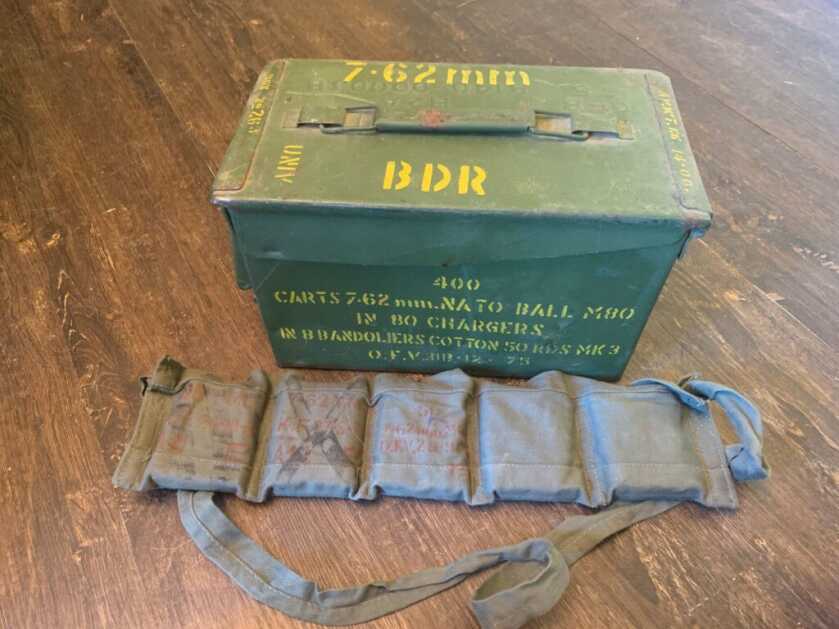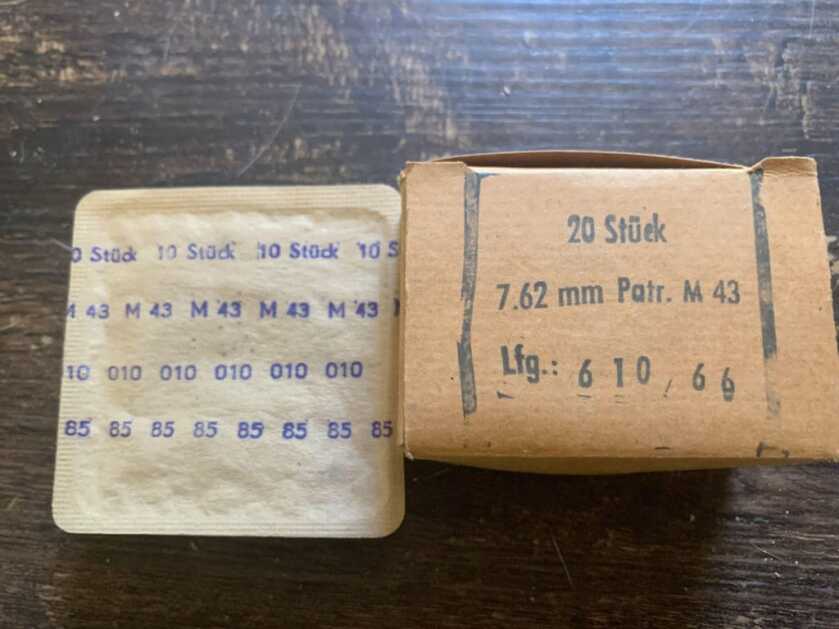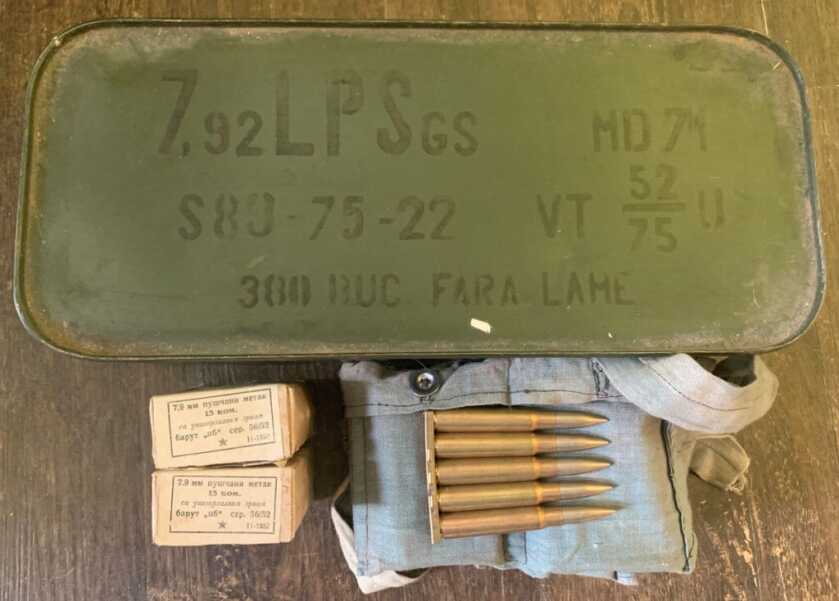Chances are if you own a firearm in a military caliber you have looked at surplus ammunition. In a nutshell, surplus ammunition is ammunition that was decided to be “surplus” to the needs of some entity. In most cases, this happens when a caliber or loading is replaced in service. If you’re not intimately familiar with it, it can be very confusing to know exactly what it is that you are looking at. A lot of times, the markings on the boxes or containers are in a foreign language. In some cases, some surplus ammo may not be suitable in the firearm in which you wish to use it for one reason or another. In this article, I’m going to hopefully shed some light on what’s what when it comes to military surplus ammo.

Some of what I’m going to discuss isn’t currently being imported for different reasons. And a few of these types haven’t been imported in quite a while. But it has already been imported in sufficient quantities that you may well run into some anyway. There is a bunch of imported ammo produced specifically for commercial sale, but that is beyond the scope of this article. The specifics of the different loads can vary depending upon who produced the ammo in question and when, so the bullet weights I’ve provided are intended to be a general idea of what to expect. There are so many variables with regards to velocity, that data on it would be almost useless. So I’m not including it here. I am also focusing on ball (FMJ) loadings here, as that’s by far what’s most common.
Typically speaking, there are one or two loads that exist for ball ammunition in a given caliber. Everyone who produces it tends to stick with them or something close for the most part. The reasons for this are pretty obvious when you start looking at what weapons each nation equipped its army with. Even going back 100 years, you find that most of the small arms then in use came from only a few places.

I’ll start with 5.56x45mm because it’s probably the most popular caliber in the US today. Fortunately, the situation with surplus 5.56 is not particularly complex, as there aren’t a whole bunch of different loadings of military ammo to deal with. There are really only 2 loads. In the mid-1980’s NATO standardized 5.56×45 as its rifle caliber. Unlike other calibers, they actually specified a particular bullet (the FN designed SS109) and load. M855 is what the US military calls that ammunition. Any 62gr 5.56mm NATO military surplus ammo will be this loading. The one exception to that rule (that I am aware of), was some Radway Green 62gr ammo that was imported about 15 years ago. It was rather lightly loaded in comparison to the typical NATO loading. At any rate, all of these loads do contain steel in the bullets which I mention because some ranges may not allow the use of it. Some nations have different nomenclatures for this ammunition, but fortunately, that information is easy enough to sort out.
The M193 load is the original 5.56x45mm loading, and it predates the actual 5.56mm NATO specifications by about 25 years (which certainly muddies the waters of the whole .223 vs 5.56mm debate). M193 uses a 55gr FMJBT bullet. It was loaded by a lot of different nations. But aside from some of them using Berdan primers, this ammo is essentially all the same.
7.62×51 NATO was standardized in the late 1950s. Unlike 5.56mm, while the cartridge was standardized the load really wasn’t. Through the years, we’ve seen a bunch of different nationalities of 7.62×51 NATO surplus ammunition imported. While there are differences in the loadings, the differences are fairly insignificant, as they were all in the 140-150gr range. The US load is 147gr, and is called M80. Some other nations also use the same nomenclature, though most did not. The situation with surplus ammo in this caliber is a bit different, so I’m going to go into a bit more detail.

I’ll start with the ammunition produced in India, as there are some things to be aware of. There are predominately 2 types of 7.62 NATO ammo that came from India, ammo packed in bandoleers on 5rd stripper clips, and ammo packed in 10 round clear plastic packages. The ammo in the 10rd plastic packages is dated from the 1990s. This ammo is responsible for the very bad reputation Indian ammo received years ago, and deservedly so. Put plainly, I would not advise shooting this ammo as it was notorious for squib loads (when the powder doesn’t burn properly and a bullet is left in the barrel) and other problems. I personally experienced squibs in this ammo when I shot some years ago. So this isn’t just internet rumors. If you handload, you could use it for some components as the brass is boxer primed at least, but even then you should inspect the bullets and brass carefully. The Indian 7.62 NATO ammo on stripper clips is dated from the 1970s and is considerably better quality. I have fired a fair amount of this ammo, and never had any problems with it. If you’re looking at Indian 7.62 NATO ammo, and you’re not 100% sure what it is, pass on it or buy it just for components. The headstamp on Indian ammo is “OFV” and a two-digit year, which I mention in case you find some not in its original packaging.

7.62 NATO produced by the various European nations (i.e. England, Germany, Austria, Spain, etc) is usually decent quality ammo. It is almost always berdan primed, and non-corrosive. As I mentioned previously, there are slight differences in the loadings of different nations, but it’s all fairly similar. The same goes for the South African ammunition as well. There is only one type of corrosive 7.62 NATO or .308 Winchester ammo that I have seen. It is Czech, and in bluish colored boxes. While I believe this ammo was intended to be for commercial sale, I have seen it advertised as surplus which is why I mention it.
Calibers from the Soviet era have become more prevalent in the US as the years have passed. These are a little bit trickier to figure out if you’re not familiar with them. Most of this ammo is packaged quite similarly. If you are lucky enough to find it in quantity, it always seems to be packed in some sort of “spam can” (or if you’re really lucky a crate). In a lot of cases, if you find this ammo in the corner of your local shop or at a gun show, the can has been opened but may still be present. These cans are about the same size, and there were a number of different calibers packed this way. In order to know what they contain, you have to be able to “read” them. Also, should you purchase any ammo packed in these, make sure you obtain one of the proper “can openers” for them.
5.45×39 is a caliber that has not been available in the US for very long in comparison to other calibers. A lot of shooters still have never heard of it. However, I really like AK-74 rifles, so it’s one of my favorite calibers. For surplus ammo, there is really only one loading available. This is the 7n6 ammunition that was banned from import a few years back. A lot of it was imported from Russia when it was allowed into the US. However, there was also some Bulgarian ammo as well. All of this ammo is corrosive. All of the Russian stuff I’ve seen was produced in the late ’70s or ’80s. It was packed in crates of 2160 rounds, containing 2 1080rd cans. Inside the cans, the ammo is packed in 30rd boxes.

Another popular caliber here in the US is 7.62x39mm. In this caliber, there are 2 specific loadings surplus ammo is found in. The M43 loading is the original load, and worldwide the most popular. However, imports of this were cut off a number of years ago owing to the steel core construction of the bullets. This was done for economic purposes, rather than enhancing penetration or armor-piercing reasons as is commonly thought, lead being more expensive than steel. At any rate, occasionally it turns up on gun show tables and similar in spite of not having been imported for some time. M43 found here is typically Chinese or East German, though it is my understanding that there have been others as well.

Like everything else weapon related, the Yugoslavs had to be different. They developed the M67 loading. We are fortunate here, as this load uses a lead core bullet and as such is still imported into the US. The vast majority of this ammo is corrosive, but I have seen some recently that was advertised as non-corrosive. It typically is in crates containing 1120 rounds or 1260 rounds. The crates of 1120 contain boxes of 40 rounds on SKS type stripper clips, while the crates of 1260 contain boxes of 15 rounds. This ammo is also brass-cased, though being Berdan primed it is a bit more work to reload.
7.62x54r has been around a long time. So naturally, there are more configurations that it was loaded and packed in. I’ve never actually encountered any 7.62x54r in the US from before WWII, and should you find any it should probably be regarded as collector ammo due to its rarity and age. So I’m going to stick to post-war loadings. I’ve primarily seen two different loadings here, the M30 (aka heavy ball) and the LPS (aka light ball) load. The heavy ball load is marked with a yellow painted tip. It’s 182grs and uses a lead core bullet. At one point it was decided that there should only be 1 ball loading in 7.62x54r and that would be the LPS loading. It’s about 147grs (there are slight variations depending on who loaded it), and the most commonly found surplus ammo. The bullet in this ammunition does contain a steel core, like the 7.62×39 ammunition I mentioned above. It was marked with a silver painted tip for a time. This practice was stopped after a while, presumably when all of the M30 ammunition was out of service. So there is a lot of it out there with no paint on the bullet tip to mark it. However, it is my understanding that all of the Yugo ammo out there in this caliber is the M30 loading, and it does not have a paint marking on the tip as they only used the M30 loading.
There is one more load out there that, while fairly rare, could still be encountered. That would be the 7n1 load. This ammunition was specifically loaded for the SVD, and is considered to be a “match” loading. It used a special 152gr BT bullet. The crates, cans, and packages of this ammo all have a marking to note what this ammo is. I would strongly advise that you do some research before purchasing any ammunition of this type.

For packaging, the most common in this country is the 440rd can, packed 2 to a crate. Inside the crate, the ammo was packed in 20rd boxes. I’ve seen it packed another way as well. Once in a great while, some will turn up in 300rd cans (these being more square then the normal “spam cans”), 2 to a crate. This ammo is packed in boxes of 15, on 5 round Mosin-Nagant clips. The only real clue to us as to which it is (if the crate is unopened), is the round count marked on the container. There is also some that are in an 800rd crate, containing 1 large can.
7.92x57mm, also known as 8x57mm and 8mm Mauser, is another caliber that has seen a large amount of ammunition imported for it. There are predominately 2 loads for this caliber as well. The 154gr load was the WWI era rifle loading, and what the sights on WWI era Mauser rifles are calibrated for. The 198gr load was the WWII era load, and obviously what’s intended for use in WWII and post-war Mausers. All of this ammo should be considered corrosive. Before using any of this ammo, ensure that it’s safe to do so in the particular rifle you intend to use it in as not all 7.92x57mm rifles are intended for the same ammunition.

This leads us to the Turkish 7.92x57mm ammo that, while not as cheap as it once was, is still floating around in sizeable quantities. It is found in cloth bandoleers, loaded in 5rd Mauser stripper clips. It is essentially a copy of the WWI era 154gr load. All of it that I have seen has been dated in the 1930s-1950s. There have been problems reported with this ammo, so I would recommend you do some research before using it. I’ve never personally had a problem with it, though I’ve only ever used it in bolt action rifles.
There have also been quantities of Romanian produced 7.92x57mm imported as well. This ammo was packed in “spam cans” like the Soviet calibers typically are. The cans were either packed with 340 or 380 rounds, with the 340rd cans having their ammo on 5rd clips. This ammo is steel cased but otherwise similar to the WWI era load being about 150grs.
Yugoslavian ammo seems to be what I find most often for 7.92x57mm surplus ammo. It is typically packed in 15rd boxes, inside of 900rd cans-though sometimes it can be found in machine gun belts. All of the Yugo 7.92mm ammo I have seen is the later 198gr loading. The Yugos also loaded special ammunition for the Zastava M76 “Sniper” rifles, which is referred to as M75. This ammo is supposed to be better quality than the typical ball ammo, but is basically the same load and is still corrosive. I have fired a fair amount of the regular ball ammo, and I’ve had pretty good luck with it.
Surplus ammunition can be an excellent value. In a lot of cases, it is packaged for long term storage, making it very suitable for people wanting to store some ammunition “for a rainy day”. A lot of it is corrosively primed, but this just requires some extra cleaning to deal with. Some of it is specifically loaded for use in a particular weapon, and may not be suitable for some firearms in that caliber. When in doubt, do some research on the specifics of the ammo in question before you use it in a particular firearm. Hopefully, this has given you a little bit of information about that dusty ammo crate sitting in the corner of your favorite shop. Until next time, Happy Shooting!

Would’ve like to see a run down of 30-06 surplus. Greek vs. Korean vs Ethiopian vs. US
Great article and very informative. I’d just like to add my two cents for any 50 cal shooters out there. If you find any ammo made in Brazil, or Argentina with yellow painted bullet tips; Don’t buy it and definitely don’t shoot it. I was lucky because my gun had a Stellite liner in the barrel or it would have blown up the gun! It was probably made for aircraft weapons that have a short life expectancy; but most of those barrels have liners in them too.
Most 50 shooters just use surplus for practice and normally shoot single shot precision rifles, so they may never run into this problem, but you can always remove the bullets and put your favorite load into it – just be careful with the Berdan primers.
I’ve bought some 303 Brit Surplus about 10 years ago, maybe 15. One set I’d have to look at but came dirty and had hang fires. All it is good for is to pull the bullets out and reload some brass with it. THe second set was actually AUS 303. Good stuff, still got 2-300 rounds of it. But I’ve got to have the ‘Gov’t Issue’ Enfield checked for head spaceing first. Got the rifle from my Dad years and years ago. (I’m usre he picked it up an some trade at some point.) Real beat up. Only shot 10-15 round thru it, ran ok, but the extractor spring broke, fixed that and then got to thinking about Head space. If possible thinking of restoration job when I retire, if possible with what I have. Some one replaced the original stock for a black Fiber one, I’ll probably end up putting more into it than it is worth, but hey, might be fun.
I didn’t get into .303 ammunition here for space constraints. Because obviously you could fill an encyclopedia sized volume with information about the various surplus ammo imported in the last 30 years and still not cover it all.
But the stuff you had duds and hangfires from was likely POF produced. It was fairly common about 15 years ago, typically coming in 32rd boxes. It was notorious for those particular problems.
I would encourage you to do some research with regards to your restoration of the Enfield. If you decide to go ahead with restoration, you will find that the original finish on the British service weapons of the day is a bit different. But it’s not particularly difficult to replicate. Replacement stocks are also available in the original pattern.
While at the range with a M1A shooting South African 7.62×51 a young man with a Remington 700 in 308 asked to try the ammo. The ammo was of a higher pressure than the 700 likes and after firing the first round his bolt refused to open. He beat the bolt open with a mallet. While 7.62×51 and 308 are nearly interchangeable most surplus ammo is designed for semi automatic and machine gun use.
Funny thing is I have had some good luck with the South African and South America 7.62. I had a 700 target that absolutely loved the Sout Africanm English and German Ball. ANother one Like the Indian ammo. GO figure!
I’ve read, but don’t really know, that the .308 round has a similar problem with the .223 in that military and civilian ammo has a different spec. I only shoot military weapons, so I don’t really have the experience; I also only shoot surplus ammo, so that also limits my scope of experience with civilian rounds. Seems like it is something about the throat specification, or length from the shoulder to the bullet end of the case. YMMV.
I have a Savage model 99F lever action .308 (7.62) that has fired almost nothing but military 7.62 ammo since the day my wife gave it to me as a birthday gift, used, purchased from a pawn shop. Previous amount of use is unknown, but I can tell you for sure that I have fired more than a thousand rounds of military ammo through it, enough that the front sight fell off!, and the rifle still functions excellently. I also pull the ball bullet out and replace it, using a Lee Hand Reloader, with a soft nose bullet suitable for hunting. Never once had the slightest problem with any round! I did, while undergoing basic training at Ft Leonard Wood, MO, have a problem with a round while firing the M14 7.62 rifle during live fire training. One round apparently, had been underloaded as the bullet stuck about half way down the barrel! We were able to push it on through with a cleaning rod, and I resumed my training. Loved that M14!